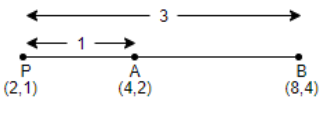
If the point P (2,1) lies on the segment joining point A (4,2) and B (8,4) then
a. $AP=\dfrac{1}{3}AB$
b. $AB=PB$
c. $PB=\dfrac{1}{3}AB$
d. $AP=\dfrac{1}{2}AB$
Answer
589.2k+ views
Hint: In order to find the solution of this question, we will find the ratio of P dividing the line segment joining A and B as $k:1$. And then we will apply the section formulae, that is, if (x, y) divides the line joining $\left( {{x}_{1}},{{y}_{1}} \right)$ and $\left( {{x}_{2}},{{y}_{2}} \right)$ in the ratio m:n, then $x=\dfrac{m{{x}_{2}}+n{{x}_{1}}}{m+n}$ and $y=\dfrac{m{{y}_{2}}+n{{y}_{1}}}{m+n}$. And hence, we will get our answer.
Complete step-by-step solution -

In this question, we have been asked to find the ratio of the line segment joining P (2,1), A (4,2) and B (8,4).
To solve this question, we will first consider the ratio of P (2,1) dividing the line joining A (4,2) and B (8,4) as k:1. And we know that if (x, y) divides the line joining $\left( {{x}_{1}},{{y}_{1}} \right)$ and $\left( {{x}_{2}},{{y}_{2}} \right)$ in the ratio m:n, then $x=\dfrac{m{{x}_{2}}+n{{x}_{1}}}{m+n}$ and $y=\dfrac{m{{y}_{2}}+n{{y}_{1}}}{m+n}$. So, we can say that if P (2,1) denotes (x, y), A (4,2) denotes $\left( {{x}_{1}},{{y}_{1}} \right)$, B (8,4) denotes $\left( {{x}_{2}},{{y}_{2}} \right)$ and k:1 denotes the ratio m:n, then by using the section formula, that is, $x=\dfrac{m{{x}_{2}}+n{{x}_{1}}}{m+n}$ and on substituting the value in it, we will get,
$2=\dfrac{k\left( 8 \right)+1\left( 4 \right)}{k+1}$
Now, we will simplify it further. So, we get,
2k + 2 = 8k + 4
Taking the terms containing the variable k on one side and the rest all terms on the other side, we get,
8k – 2k = 2 – 4
6k = -2
$k=-\dfrac{2}{6}=-\dfrac{1}{3}$
Hence, we get the ratio of P (2,1) dividing the line joining A (4,2) and B (8,4) as $-\dfrac{1}{3}$, that is it divides the line externally in the ratio 1:3. We can represent it as follows
Hence, we can say that if PA = x, then PB will be 3x. So, we can say that AB = PB – PA = 3x – x = 2x. Hence, we can say,
$\begin{align}
& \dfrac{PA}{AB}=\dfrac{x}{2x} \\
& \dfrac{PA}{AB}=\dfrac{1}{2} \\
& PA=\dfrac{1}{2}AB \\
\end{align}$
Hence, we obtained the relation between the line segments joining P, A and B as $AP=\dfrac{1}{2}AB$. Therefore, option (d) is the correct answer.
Note: While solving this question, we can also use the relation of the y coordinates of the points P, A and B to get the ratio k:1. Also, we can verify our answer by finding the value of k from both the coordinates. Also, the possible mistake one can make in this question is by choosing the option (a), that is $AP=\dfrac{1}{3}AB$, but this is wrong, as we have obtained $\dfrac{PA}{PB}=\dfrac{1}{3}$ and not $\dfrac{PA}{AB}=\dfrac{1}{3}$.
Complete step-by-step solution -

In this question, we have been asked to find the ratio of the line segment joining P (2,1), A (4,2) and B (8,4).
To solve this question, we will first consider the ratio of P (2,1) dividing the line joining A (4,2) and B (8,4) as k:1. And we know that if (x, y) divides the line joining $\left( {{x}_{1}},{{y}_{1}} \right)$ and $\left( {{x}_{2}},{{y}_{2}} \right)$ in the ratio m:n, then $x=\dfrac{m{{x}_{2}}+n{{x}_{1}}}{m+n}$ and $y=\dfrac{m{{y}_{2}}+n{{y}_{1}}}{m+n}$. So, we can say that if P (2,1) denotes (x, y), A (4,2) denotes $\left( {{x}_{1}},{{y}_{1}} \right)$, B (8,4) denotes $\left( {{x}_{2}},{{y}_{2}} \right)$ and k:1 denotes the ratio m:n, then by using the section formula, that is, $x=\dfrac{m{{x}_{2}}+n{{x}_{1}}}{m+n}$ and on substituting the value in it, we will get,
$2=\dfrac{k\left( 8 \right)+1\left( 4 \right)}{k+1}$
Now, we will simplify it further. So, we get,
2k + 2 = 8k + 4
Taking the terms containing the variable k on one side and the rest all terms on the other side, we get,
8k – 2k = 2 – 4
6k = -2
$k=-\dfrac{2}{6}=-\dfrac{1}{3}$
Hence, we get the ratio of P (2,1) dividing the line joining A (4,2) and B (8,4) as $-\dfrac{1}{3}$, that is it divides the line externally in the ratio 1:3. We can represent it as follows
Hence, we can say that if PA = x, then PB will be 3x. So, we can say that AB = PB – PA = 3x – x = 2x. Hence, we can say,
$\begin{align}
& \dfrac{PA}{AB}=\dfrac{x}{2x} \\
& \dfrac{PA}{AB}=\dfrac{1}{2} \\
& PA=\dfrac{1}{2}AB \\
\end{align}$
Hence, we obtained the relation between the line segments joining P, A and B as $AP=\dfrac{1}{2}AB$. Therefore, option (d) is the correct answer.
Note: While solving this question, we can also use the relation of the y coordinates of the points P, A and B to get the ratio k:1. Also, we can verify our answer by finding the value of k from both the coordinates. Also, the possible mistake one can make in this question is by choosing the option (a), that is $AP=\dfrac{1}{3}AB$, but this is wrong, as we have obtained $\dfrac{PA}{PB}=\dfrac{1}{3}$ and not $\dfrac{PA}{AB}=\dfrac{1}{3}$.
Recently Updated Pages
Two men on either side of the cliff 90m height observe class 10 maths CBSE

What happens to glucose which enters nephron along class 10 biology CBSE

Cutting of the Chinese melon means A The business and class 10 social science CBSE

Write a dialogue with at least ten utterances between class 10 english CBSE

Show an aquatic food chain using the following organisms class 10 biology CBSE

A circle is inscribed in an equilateral triangle and class 10 maths CBSE

Trending doubts
Why is there a time difference of about 5 hours between class 10 social science CBSE

Write a letter to the principal requesting him to grant class 10 english CBSE

What is the median of the first 10 natural numbers class 10 maths CBSE

The Equation xxx + 2 is Satisfied when x is Equal to Class 10 Maths

Which of the following does not have a fundamental class 10 physics CBSE

State and prove converse of BPT Basic Proportionality class 10 maths CBSE




